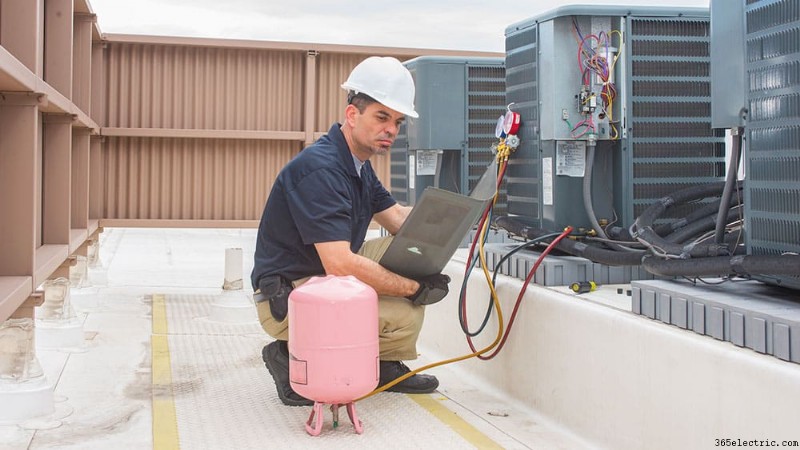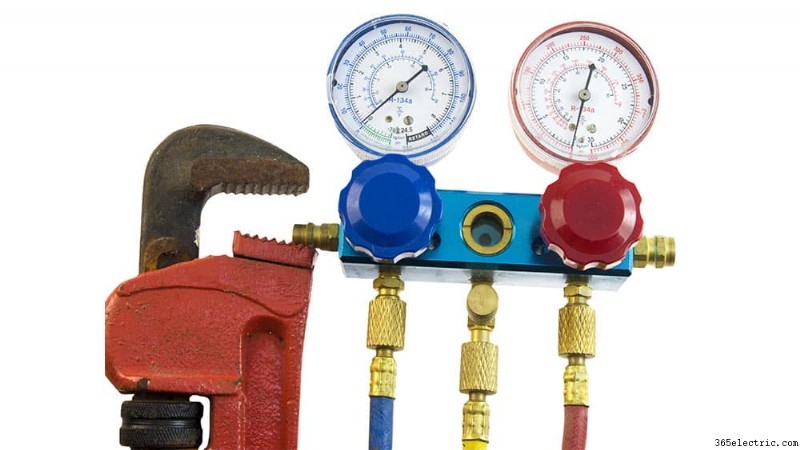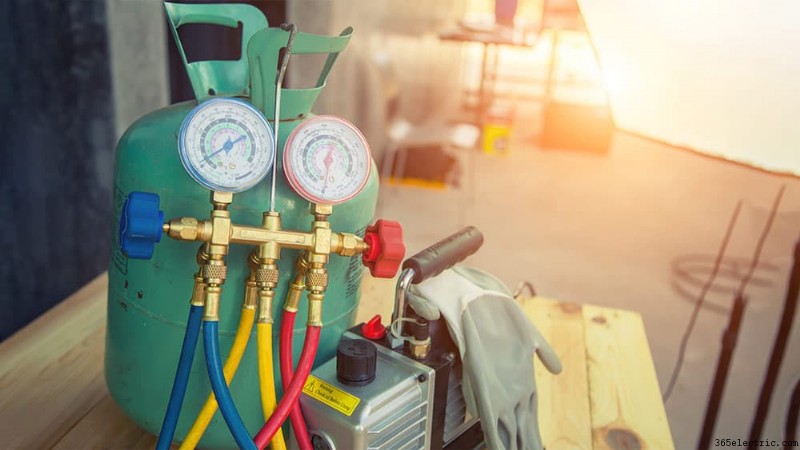
Os refrigerantes AC são a força invisível por trás do funcionamento do seu ar condicionado. A capacidade do seu ar condicionado para refrigerar depende disso. Os refrigerantes absorvem o calor e fornecem ar frio à medida que passa pelo compressor e pelo evaporador.
A manutenção HVAC geralmente requer a necessidade de verificar o nível de refrigerante do seu sistema HVAC. Se o nível de refrigerante não for adequado, seu sistema terá que trabalhar mais e não poderá resfriar como desejado.
Se você depende de seu ar condicionado ou bomba de calor, é bom aprimorar seus conhecimentos de HVAC. Leia e conheça seus refrigerantes AC e seja capaz de identificar e corrigir quaisquer problemas potenciais imediatamente.
O que é um refrigerante CA?
Como você deve ter adivinhado, um refrigerante AC ajuda na função de resfriamento não apenas do seu ar condicionado, mas também de uma geladeira, freezer ou qualquer outro aparelho que use resfriamento.
Para saber mais sobre a função de um refrigerante AC, é importante saber como funciona um ar condicionado. Um ar condicionado funciona usando o refrigerante, que está dentro das bobinas de cobre no evaporador e no condensador, para absorver o calor da sala e expulsá-lo para o ambiente externo. Durante este processo, o refrigerante muda de um gás de baixa pressão para um líquido de alta pressão.
Esta é a explicação mais simples para o ciclo de refrigeração. O líquido de alta pressão então sopra com um ventilador para expulsar o calor para o ambiente. Para iniciar o próximo ciclo, esse líquido comprime ainda mais e, em seguida, é ejetado rapidamente de um bico especial para convertê-lo em gás novamente. Este gás frio então sopra com outro ventilador para injetar ar frio na sala e o ciclo continua.
A história dos refrigerantes AC
A primeira tentativa de um refrigerante AC foi em 1928, pelo esforço conjunto de Thomas Midgley, Albert Henne e Robert McNary. Eles descobriram esses compostos enquanto trabalhavam na divisão de ar condicionado da General Motors. A General Motors procurou produzir uma alternativa não tóxica e não inflamável a outros refrigerantes da época, como dióxido de enxofre ou amônia. Seus refrigerantes eram da classe de refrigerantes clorofluorcarbono (CFC), conhecidos por sua marca, Freon.
O refrigerante AC primário que foi descoberto foi o R-22, um hidrofluorcarbono (HCFC). Ele encontrou amplo uso como refrigerante nas próximas décadas como o refrigerante de escolha devido às suas propriedades favoráveis.
No final dos anos 80, quando o mundo chamou a atenção para as taxas crescentes de aquecimento global e outros fatores ambientais, os CFCs e HCFCs passaram a ser mais examinados. Eles estavam danificando a camada de ozônio e foram banidos devido aos seus efeitos devastadores. Em 1987, eles foram colocados na lista de substâncias proibidas do Protocolo de Montreal e lentamente eliminados.
Tipos de refrigerantes AC
Clorofluorcarbonos (CFCs) A produção de CFCs, também conhecidos como Freon, foi descontinuada em 1995. Alguns exemplos desses refrigerantes são R11, R12 e R115. Eles foram considerados inseguros para o meio ambiente contribuindo para a destruição da camada de ozônio e o efeito estufa.
Refrigerante R22 R22 ou Freon 22 é um refrigerante HCFC que é basicamente um clorofluorcarbono, mas com um átomo de hidrogênio para diminuir sua vida útil no meio ambiente. Depois dos CFCs, eles se tornaram o uso padrão em condicionadores de ar de 1960 até serem completamente eliminados ao serem banidos para uso em novos condicionadores de ar em 2010.
Se o seu ar condicionado foi instalado antes de 1º de janeiro de 2010, provavelmente usava R22, embora você possa obter isso a um custo crescente antes, ele é completamente interrompido em 2020.
O R22 também está ligado a danos ambientais, razão pela qual foi banido pela Agência de Proteção Ambiental (EPA).
Refrigerante R410A A proibição do R22 exigiu a introdução de um novo refrigerante AC R410A, também conhecido como Puron. O R-410A é um refrigerante sem cloro tornando-o muito menos prejudicial ao meio ambiente sem perder suas características de resfriamento.
It is essential to be careful since HVAC appliances intended for R-22 cannot be used with R-410A, considering its higher operating pressures.
Moreover, R-410A permits higher for an HVAC system, as compared to one using R-22 as well as better air quality and comfort. With higher SEER and lower power consumption there is an added benefit of lowering the total demand for power plants, thus reducing greenhouse emissions.
Replacing R-22 With R-410A
With R-410A being mandated by the government, the phase-out for R-22 has been a concern for many homeowners. If you already have an air conditioning system using R-22, worry not; you won’t have to throw it out.
The government protocols only concern manufacturers and bans them from making R-22 compatible air conditioners or R-22 itself after January 2020. You can keep on using your old air conditioner as it is. If there is a need to recharge it with refrigerant after 2020, your HVAC technician will have to source recycled R-22 for replenishment.
At the end of your old conditioner’s lifecycle and when the time comes to replace it, you will be restricted to only buying R-410A compatible air conditioners.
But it might just be better to make the switch early. R-410A is safer for the environment and gives you much greater energy efficiency as compared to R-22 thus reducing your energy bills.
Refrigerants are not the only way of saving energy, though. Read on about the 101 tips through which you can reduce your energy expenses.
R32 – The Future of Refrigerants
With time, refrigerants have been making progress, and now it is time for a new class of AC refrigerants, known as R-32. The result? Lower energy consumption and even lower environmental impact. Let’s see how.
R-32 is the talk of the town these days, and for a good reason. For one, it has a Global Warming Potential (GWP) which is 32% that of R-410A. The GWP is a measure of how much emissions a chemical substance is contributing to the environment. A lower GWP means fewer emissions and more environmentally friendly refrigeration.
Moreover, systems that use R-32 consume up to 20% less refrigerant in the system, saving up on costs even further.
Even though there is still some time in the widespread adoption of R-32, the future is very bright for this class of refrigerants. With countries such as Japan and China already implementing it, it is only a matter of time before the world at large moves towards these higher efficiencies. In the US reports suggest half of window ACs sold in 2018 used R32.
Which Refrigerant Does My Air Conditioner Use?
If your air conditioning system was built before 2010, there is a high chance that your AC has R-22. But there’s an even more authentic way to find out. You can look at the appliance description sticker on the side of the air conditioner’s outdoor unit. The type of AC refrigerant is written there. You can find it on the user manual, or you can contact your HVAC service representative and find out!
How Do I Tell If My AC Refrigerant Needs Work?

Now that you have a brief background on refrigerants and what they do, it helps be aware of some of the . The refrigerant in an AC is not something that you should generally worry about. They are built to outlast your air conditioner. But in rare cases, there can be a leak of the refrigerant, and you would need to top it up. We’ll go over some of the common problems below:
- Cool Air Not Coming Out of AC Vents:
If your AC is in cool mode, but there is room temperature air being blown out, you need to look at your refrigerant. This is by far the most common problem. An AC refrigerant is required to provide cooling, and without a refrigerant, it would not be able to do so.
There can be other causes for such a problem too, but a sudden shift from cool air to room temperature air is a tell-tale sign that your AC refrigerant leaks.
If you take a glance within your ductless indoor unit, you will see a network of copper coils, dark gold in color. The refrigerant flows to provide cooling within these coils. These coils are very icy to touch, but they should not be having frost over them in regular operation. If you see signs of frost on the coils, there is a high chance that the refrigerant could be leaking.
It is better to have , especially before the start of a busy season. For air conditioners, this is just before summers start. At this time, a good HVAC technician can spot an AC refrigerant leak
, and propose remedial measures.
The cause of leaks can be various. It can be a manufacturing defect, which has surfaced after prolonged usage, or because of damage encountered during use.
What Is the Solution to an AC Refrigerant Leak?
AC refrigerant leaks can be worrying, but they are extremely common. Let’s look at how to solve this common issue and keep your air conditioner running in top shape.
Recharging Your Refrigerant

Recharging means to top up your air conditioner with more refrigerant. If your system is low on refrigerant, you won’t get enough cool air coming out of your vent. Thus,
the recharge is imperative.
A recharge should only be done by a professional contractor
, due to the high levels of pressure involved. Moreover, there is increased risk of damage to your air conditioner, which can result in an even higher bill.
Your professional contractor will also find out any major underlying problem, such as a much larger leak
, or loose fittings. These can cause problems further down the road as well. He will fix any minor leaks or issues on the spot
, and recharge your air conditioner with refrigerant. Your AC will be functional in no time again!


